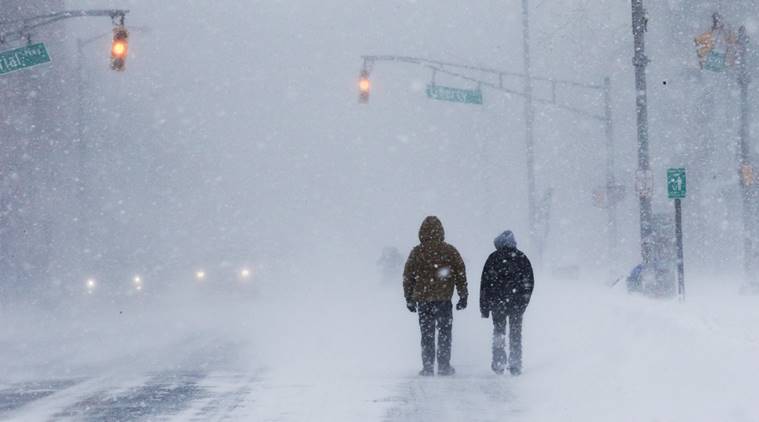Home
/
What is ‘bomb cyclone’ and why is it freezing USA?
/
What is ‘bomb cyclone’ and why is it freezing USA?
What is ‘bomb cyclone’ and why is it freezing USA?
What is ‘bomb cyclone’ and why is it freezing USA?
Worldwide, about 40 to 50 ‘bomb cyclones’ brew each year, but most are over open ocean and nobody but weather geeks notice.
 According to reports, temperatures fell as low as -42 degrees Celsius across much of the eastern area.
According to reports, temperatures fell as low as -42 degrees Celsius across much of the eastern area.
RELATED NEWS
As northern India shivers due to the prevailing cold wave, 8,431 miles away, in the United States of America, a ‘bomb cyclone’ is causing exposed skin to freeze within 30 minutes.
The United States East Coast and Midwest are battling record-breaking low temperatures as cold Arctic air continues to sweep through the region followed by the freezing winter storm — bomb cyclone or bombogenesis.
The winter storm has reportedly claimed at least 18 lives, including four in traffic accidents in North Carolina and three in Texas. According to reports, temperatures fell as low as -42 degrees Celsius across much of the eastern area. Authorities issued warnings saying there was an impending risk of frostbite. The cold weather disrupted flight services and caused power outages in tens of thousands of homes in the US.
The cyclone, scientists explained, is essentially a storm caused by a collision of warm air and cold air which develop into rotating storm-like pattern and lead to an explosive deepening of pressure. The East Coast’s first snowstorm of 2018 was energised by this rapid drop in barometric pressure.
See photos of the winter storm and blizzard here
 People struggle against wind and snow during Storm Grayson at the Jersey shore in Long Branch, New Jersey. (Reuters)
People struggle against wind and snow during Storm Grayson at the Jersey shore in Long Branch, New Jersey. (Reuters)
A storm is considered a ‘bomb’ when the pressure drops rapidly — at least 24 millibars in 24 hours. Bomb cyclones also draw air from polar regions after it weakens. This explains the Arctic air freezing parts of US.
From New England to Ohio, weather warnings have been issued including for Pennsylvania, while the National Weather Service warned of freezing rain in Missouri and areas to the northeast. In some of those places, exposed skin could freeze within 30 minutes, meteorologist Dan Petersen of the National Weather Service’s Maryland-based Weather Prediction Center was quoted as saying by Reuters. Meteorologists also predicted that thawing should begin on Monday and bring some relief.
 A man walks across Boston Common following winter snow storm Grayson in Boston, Massachusetts. (Reuters)
A man walks across Boston Common following winter snow storm Grayson in Boston, Massachusetts. (Reuters)
“This is a serious, serious storm,” New York Mayor Bill de Blasio said at a news conference. “We expect tough conditions for days to come, particularly in terms of cold.” According to reports, New York had almost eight-nine inches of snow across the city. Blasio had also said it could feel like – 20 degrees on Friday and Saturday nights.
 A pedestrian walks through blinding snow across the Brooklyn Bridge during Storm Grayson in New York City. (Reuters)
A pedestrian walks through blinding snow across the Brooklyn Bridge during Storm Grayson in New York City. (Reuters)
“The magnitude of the cold and the area of coverage of the cold is really what’s impressive to me,” meteorologist Ed Vallee told Reuters.
In New Hampshire, the ambient air temperature on Mount Washington plunged to -36 F (minus 38C), two degrees short of a record low for January 6. But sustained winds of 159 km/h and gusts of up to 180 km/h atop the 6,200-foot (1,990-metre) peak made it feel more like minus 92 F (-69 Celsius). The New York Times reported that the cold winds at the summit is causing freezing of eyelashes. The storm also led to coastal flooding in areas around New England.
The scene at my backyard swimming pool this 40-degree South Florida morning: A frozen iguana. pic.twitter.com/SufdQI0QBx— Frank Cerabino (@FranklyFlorida) January 4, 2018
In Florida, iguanas and green lizards were falling off trees after being “stunned by the cold.” The temperature in Gulf of Mexico waters has “cold-stunned” sea turtles in Texas, causing them to float to the surface and making them vulnerable to predators. The National Park Service had rescued 41 live turtles by midday Tuesday, The Guardian reported.
In Massuchusetts’ Cape Cod, the Atlantic White Shark Conservancy reported the strandings of three thresher sharks out of which two were probably suffering from “cold shock” while the third had frozen solid. In Canada, which is also battling extreme weather conditions, the Calgary Zoo announced that it was moving its king penguins inside amid -13F (-25C) temperatures.
 Pedestrians battle the blowing snow and wind chills around minus 30 degrees celsius (minus 22 degrees Fahrenheit), Friday in Montreal. (The Canadian Press via AP)
Pedestrians battle the blowing snow and wind chills around minus 30 degrees celsius (minus 22 degrees Fahrenheit), Friday in Montreal. (The Canadian Press via AP)
What is ‘bomb cyclone’ and why is it freezing USA?
![What is ‘bomb cyclone’ and why is it freezing USA?]() Reviewed by TechNow
on
January 07, 2018
Rating: 5
Reviewed by TechNow
on
January 07, 2018
Rating: 5






No comments